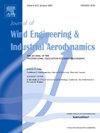带桁架梁的新概念缩尺气动弹性模型及其验证
IF 4.2
2区 工程技术
Q1 ENGINEERING, CIVIL
Journal of Wind Engineering and Industrial Aerodynamics
Pub Date : 2024-11-20
DOI:10.1016/j.jweia.2024.105958
引用次数: 0
摘要
气动弹性模型或桁架梁的精度一直是影响全桥气动弹性风洞试验结果的决定性因素。针对缩小比例的加劲梁模型,引入了一种新颖的设计方法,即 "多刺框架系统"。该系统采用了多刺、较薄的梁和柱,在精确模拟整体刚度、质量和约束的同时,最大限度地减少了气动干扰。设计程序被表述为一个优化问题,目标是优化气动弹性模型的低阶固有频率(横向弯曲、垂直弯曲和扭转)。采用模式搜索法和惩罚函数来确定局部最优解,以满足该优化问题的工程应用。该设计方法被应用于一个实际项目,涉及一座桁架梁四索悬索桥,测试结果证明了该方法在模拟气弹模型动态特性方面的准确性。通过相应的风洞扑动不稳定性试验以及多模态扑动数值分析,对该桥的临界扑动速度、振型和频率进行了分析。此外,通过改变边界条件、质量分布和刚度分布实现的十种设计方案,研究了结构模态振型和固有频率偏差对扑动不稳定性的影响。由于模态振型的偏差,临界扑翼速度出现了显著差异(高达 9%),强调了在气动弹性模型设计中考虑模态频率和其他模态信息(如模态振型)的必要性。该方法通过引入有效的系统和优化方法,为今后的风失稳和结构动力学研究提供了基础,同时也强调了在扑动分析中准确表示模态振型的重要性,从而推动了桁架梁桥气动弹性模型设计的发展。本文章由计算机程序翻译,如有差异,请以英文原文为准。
A new concept reduced scale aeroelastic model of the four-cable suspension bridge with truss girder and its validation
The accuracy of the aeroelastic model or truss girders has consistently been a decisive factor influencing the results of full-bridge aeroelastic wind tunnel tests. A novel design approach, termed the Multi-Spine Frame System, is introduced for the reduced-scale model of the stiffening girder. This system incorporates multiple spines, thinner beams and columns to minimize aerodynamic interference while accurately simulating overall stiffness, mass, and constraints. The design procedure is formulated as an optimization problem with the objective of optimizing the low-order natural frequencies (lateral bending, vertical bending, and torsion) of the aeroelastic model. Pattern search method and penalty functions are employed to identify a locally optimal solution that satisfies engineering applications for this optimization problem. This design method is applied to an actual project involving a four-cable suspension bridge with a truss girder, and the test results demonstrate the accuracy of this approach in simulating the dynamic characteristics of the aeroelastic model. Corresponding wind tunnel tests on flutter instability, as well as numerical multi-modal flutter analysis, are conducted to analyze the critical flutter speed, vibration shapes, and frequencies of this bridge. Furthermore, the impact of deviation in structural mode shapes and natural frequencies on flutter instability is investigated using ten design schemes achieved by altering boundary conditions, mass distributions, and stiffness distributions, were examined. Significant differences in critical flutter speed (up to 9%) are observed due to deviations in mode shapes, emphasizing the necessity of considering modal frequencies and other modal information, such as mode shapes, in aeroelastic model design. This approach contributes to the advancement of aeroelastic model design for bridges with truss girders by introducing an effective system and an optimization method, providing a basis for future studies on wind instability and structural dynamics and also underscores the importance of accurate mode shape representation in flutter analysis.
求助全文
通过发布文献求助,成功后即可免费获取论文全文。
去求助
来源期刊
CiteScore
8.90
自引率
22.90%
发文量
306
审稿时长
4.4 months
期刊介绍:
The objective of the journal is to provide a means for the publication and interchange of information, on an international basis, on all those aspects of wind engineering that are included in the activities of the International Association for Wind Engineering http://www.iawe.org/. These are: social and economic impact of wind effects; wind characteristics and structure, local wind environments, wind loads and structural response, diffusion, pollutant dispersion and matter transport, wind effects on building heat loss and ventilation, wind effects on transport systems, aerodynamic aspects of wind energy generation, and codification of wind effects.
Papers on these subjects describing full-scale measurements, wind-tunnel simulation studies, computational or theoretical methods are published, as well as papers dealing with the development of techniques and apparatus for wind engineering experiments.

 求助内容:
求助内容: 应助结果提醒方式:
应助结果提醒方式:


